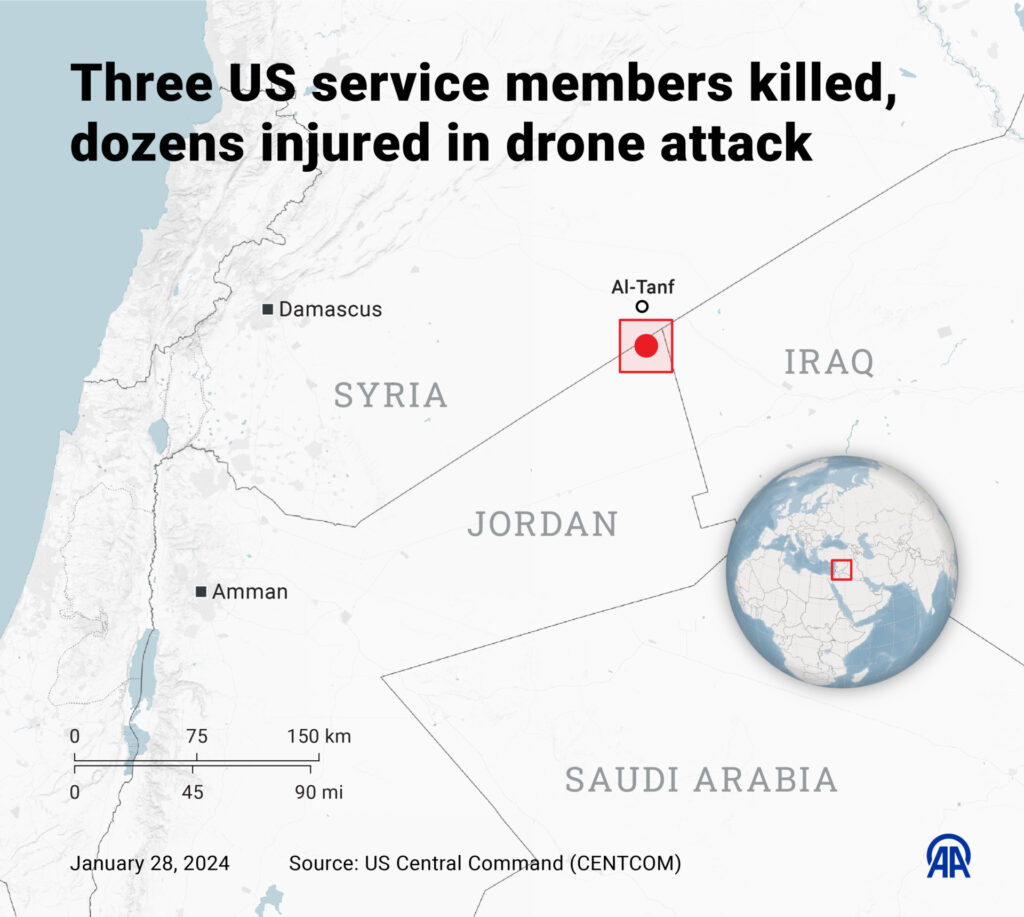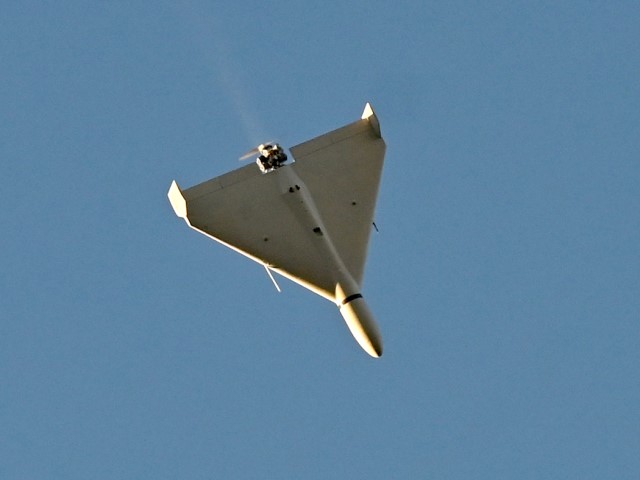A January 28 report from the Wall Street Journal suggests that U.S. armed forces were caught by surprise when an enemy drone struck an American military facility in Jordan. Thanks to new American technology, we have the capacity to stop such drone attacks, but we aren’t there yet. In the meantime, three GIs are dead, and several dozen are wounded.
The Journal reported:
A U.S. official said Sunday that the attack took place overnight at Tower 22, a small outpost in Jordan that is near the Syria border. The drone struck living quarters for the troops, which contributed to the high casualties, a U.S. official said. [emphasis added]
This reporting indicates that the Tower 22 living quarters were a “soft target.” That is, a structure not “hardened” to protect those inside. The Journal continues:
Tower 22 is located close to Al Tanf Garrison in southeastern Syria, where U.S. forces have worked with local partners combating Islamic State militants. Tower 22 has served as a logistics hub for Al Tanf and, unlike the garrison, hasn’t previously been targeted in the recent series of Iran-backed militia attacks. [emphasis added]
As think-tank analyst Andrew Tabler told the newspaper, “Tower 22 would probably be less defended than Al Tanf and any other U.S. position in Syria because it is across the border in Jordan.”

Elmurod Usubaliev/Anadolu via Getty Images
So, these soldiers were behind-the-lines logistics personnel. They—or, more pertinently, their commanders—weren’t expecting a drone attack. Hmm. Americans are fighting terrorists and militants backed by Iran, and yet they weren’t expecting an attack because they weren’t in Syria; they were in Jordan, the next country over.
Does that seem to be a failure of imagination? As in, American leaders, somewhere in the chain of command—from the field to Central Command to Washington, DC—failed to imagine that the foe would reach across a border. These are the bad guys, including Iran, who routinely refer to the U.S. as “The Great Satan.” So yeah, maybe it should have been foreseen that a borderline in the desert wouldn’t mean anything to anti-American killers.
But let’s let others worry about the geopolitics, including the basic question of whether or not we should even be fighting in Syria. For now, let’s focus on keeping Americans safe wherever they are in the world—including on the homefront.
Those with long memories might recall the fate of an earlier logistics unit in the Middle East, the 14th Quartermaster Detachment of the U.S. Army Reserve. During Operation Desert Storm, the American mission to liberate Kuwait from Iraq, the 14th Quartermaster was far behind the front lines—in Saudi Arabia, in fact—working on water purification. And yet, on February 25, 1991, an Iraqi Scud missile hit the 14th’s barracks, a non-hardened facility. Thirteen soldiers were killed and 43 wounded.
Yes, war is hell, but long-range missiles mean that the “front” is everywhere. And so adequate military preparation—and life preservation—would have meant that the men and women of the 14th were either better sheltered or dug into foxholes or more spread out.
As it happened, the fate of the 14th was somewhat akin to the fate of another too-close cluster of Americans, the Marines at the barracks in Beirut, Lebanon, who were truck-bombed back in 1983. In that debacle, hundreds died. And if we wish, we can go back to the worst moment when Americans were caught by surprise with too many eggs in the same basket, Pearl Harbor. And yes, too, there’s that ultimate calamitous failure of imagination: 9/11.

An explosion at the Naval Air Station, Ford Island, Pearl Harbor during the Japanese attack on December 7, 1941. Sailors stand amid wrecked watching as the USS Shaw explodes in the center background. The USS Nevada is also visible in the middle background, with her bow headed toward the left. (Fox Photos/Getty Images)

Hijacked United Airlines Flight 175 from Boston crashes into the south tower of the World Trade Center and explodes at 9:03 a.m. on September 11, 2001, in New York City. (Spencer Platt/Getty Images)
Today’s big new challenge is the drone. The U.S. has been using drones for decades, both for surveillance and for offensive missile strikes. Yet drones keep getting smaller, to the point where they are a little larger than birds, and they’re easy to form into swarms that can “kamikaze” the target. The testbeds for much of this new technology are Ukraine and Russia; each side is swarming the other with drones, such that familiar movements of tanks and infantry are no longer possible. Just on January 26, a Russian serviceman recalled seeing a “flock of Ukrainian FPV [first person view] drones led by a repeater drone Queen;” the aerial armada descended onto Russian positions and started blasting. And this video, released on January 22, shows a drone literally chasing a soldier in a circle and then blowing him up; it’s like a cartoon, except it’s not funny to be dead.
Drones are a disruptive technology. They are so cheap to mass-produce (the Ukrainians have been making them out of cardboard) and so nimble (lightly trained civilians can FPV them) that they call into question our ability to defend large assets, from tanks to bases to aircraft carriers. We can’t expect, for example, the Patriot missile, which is 17 feet long, to stop a hundred or a thousand or a million drones. Even Israel’s vaunted Iron Dome has been overwhelmed at times by mass volleys of Palestinian drones and homemade rockets. The idea of missile defense was designed for…missiles. These tiny drones are more like mosquitoes.

A drone flies over Kyiv during an attack on October 17, 2022, amid the Russian invasion of Ukraine. (SERGEI SUPINSKY/AFP via Getty Images)
So even more recent air-defense systems, such as the Coyote, made by Raytheon–which was used at Tower 22–are still based on the idea of anti-missile missiles.
We can add a grim note of warning: The homefront is one giant soft target. There’s probably not a private home or commercial office building in the U.S. that’s protected against a drone attack. And what of public meeting places, such as stadiums? Fuhgeddaboudit. As for U.S. government facilities—from military sites to the Capitol to the White House—well, we’ll have to see. But let’s keep in mind: The commanders of Tower 22 didn’t seem to think they had anything to worry about; a follow-on report from the Wall Street Journal on January 29 told that the Tower 22 crew had mistaken the onrushing enemy drone for a drone of its own. Was that a failure of technology? Of training? Or has the enemy gotten really good at tricking IFF? And if Americans can be spoofed by an aerial intruder in Jordan, could we spoofed in the U.S.? Or, of course, as another possibility, the whole story about the sneaky enemy drone could be a cover story of some kind. Cover for what? Well, that’s what thorough and impartial inquiries are for–to get to the truth, whatever it is.
Fortunately, there is hope for defenders if we smarten up. Such smartening entails a paradigm shift in thinking from kinetics to electronics. Instead of knocking down an incoming projectile with an outgoing projectile, the new idea is stopping it with an electromagnetic pulse (EMP). That’s a burst of microwave energy that fries the avionics of the drone, destroying its guidance. One big advantage of EMP is that it is relatively unlimited; it doesn’t depend on “ammunition” as commonly understood, but rather, on electronic “juice,” which is cheaper and, of course, as fast as the speed of light. Still, EMP is different from the force fields of science fiction; an “astrodome”-type shield is possible someday, but it would be such an energy hog that it would likely need a nuclear reactor nearby.
One company working on EMP (also called HPM, high-powered microwave, or simply, Directed Energy) is Southern California-based Epirus. Launched in 2018, it’s named after a bow from Greek mythology that didn’t need arrows—it just fired away. A co-founder of Epirus is Joe Lonsdale; back in 2003, he co-founded Palantir, which has emerged as a “prime” defense contractor focused on big data and artificial intelligence. (The other new “prime” contractor is Elon Musk’s SpaceX.)
Epirus has earned contracts with the Pentagon, although, in a January 28 interview with Breitbart News, Lonsdale expressed frustration with the overall slowness of the process. “There are a lot of smart generals and admirals who want to see change,” he said. And yet there’s a cumbersome acquisition process—sometimes like molasses. Still, in the wake of the attack in Jordan, Lonsdale is confident that the pace of EMP deployment will accelerate: “This is a time for great leaders to do great things…lives are on the line.”
So that’s where we’re headed: Companies such as Epirus—and other tech-minded newbies driven by the zeal of young founders, such as Palmer Luckey’s Anduril—are pioneering the needed paradigm shift: Less aluminum and steel, more apps and zaps. The U.S. will likely always need boots on the ground (even if some might be robotic), but soon, the sky will be defended by the real-world realizations of ray guns and photon torpedoes.

COMMENTS
Please let us know if you're having issues with commenting.